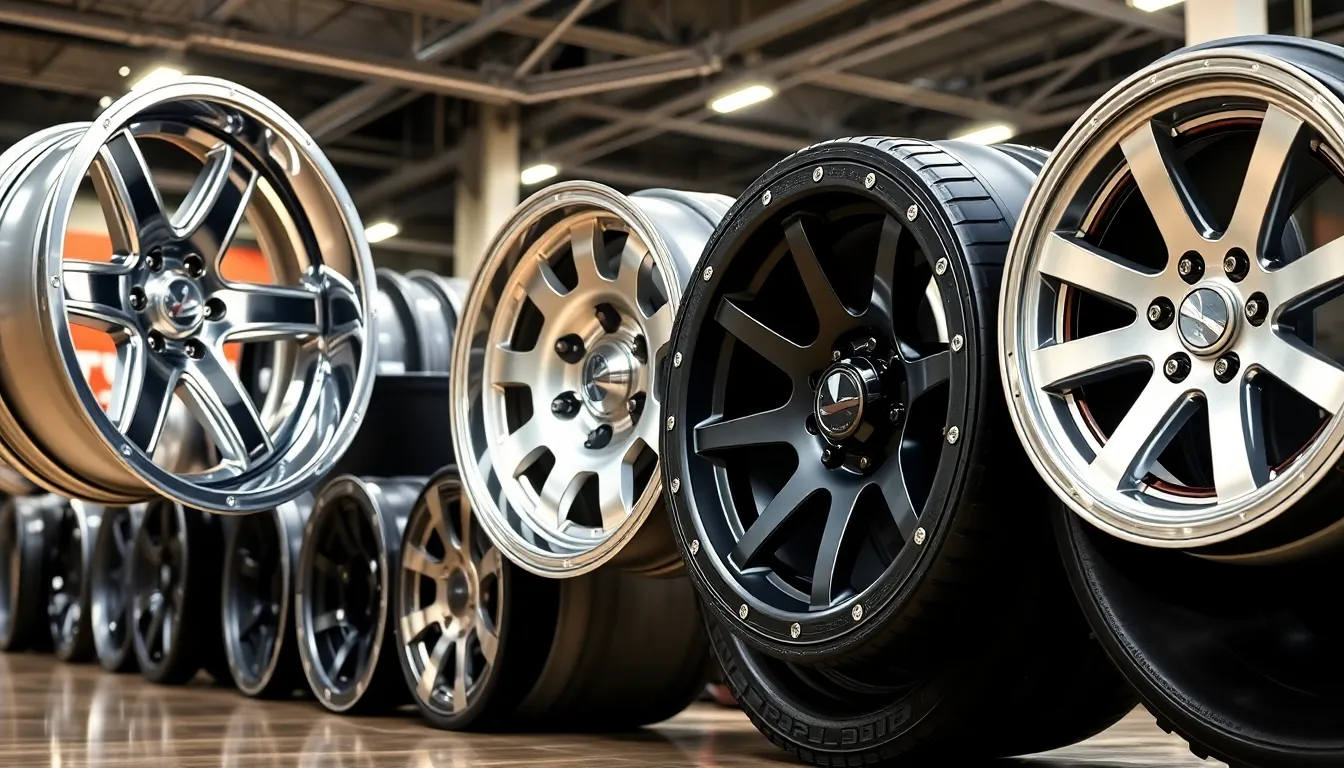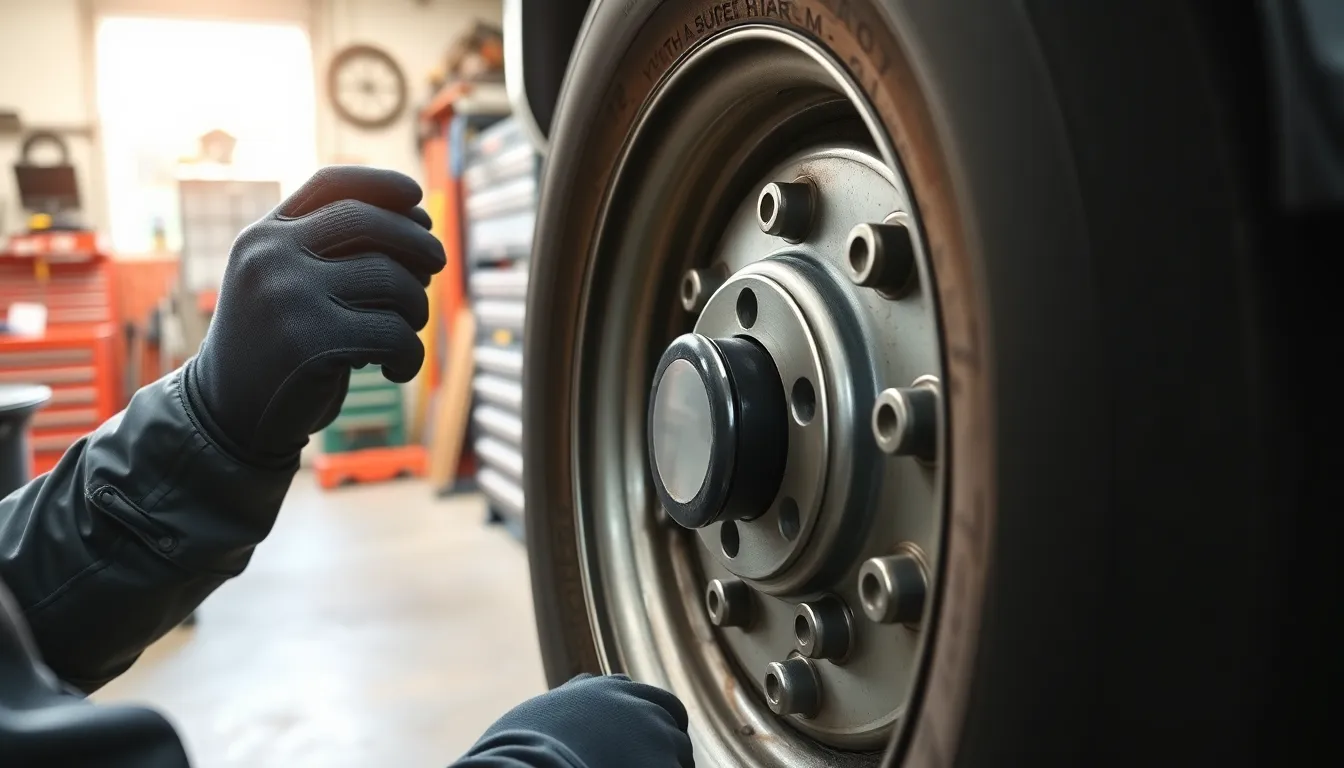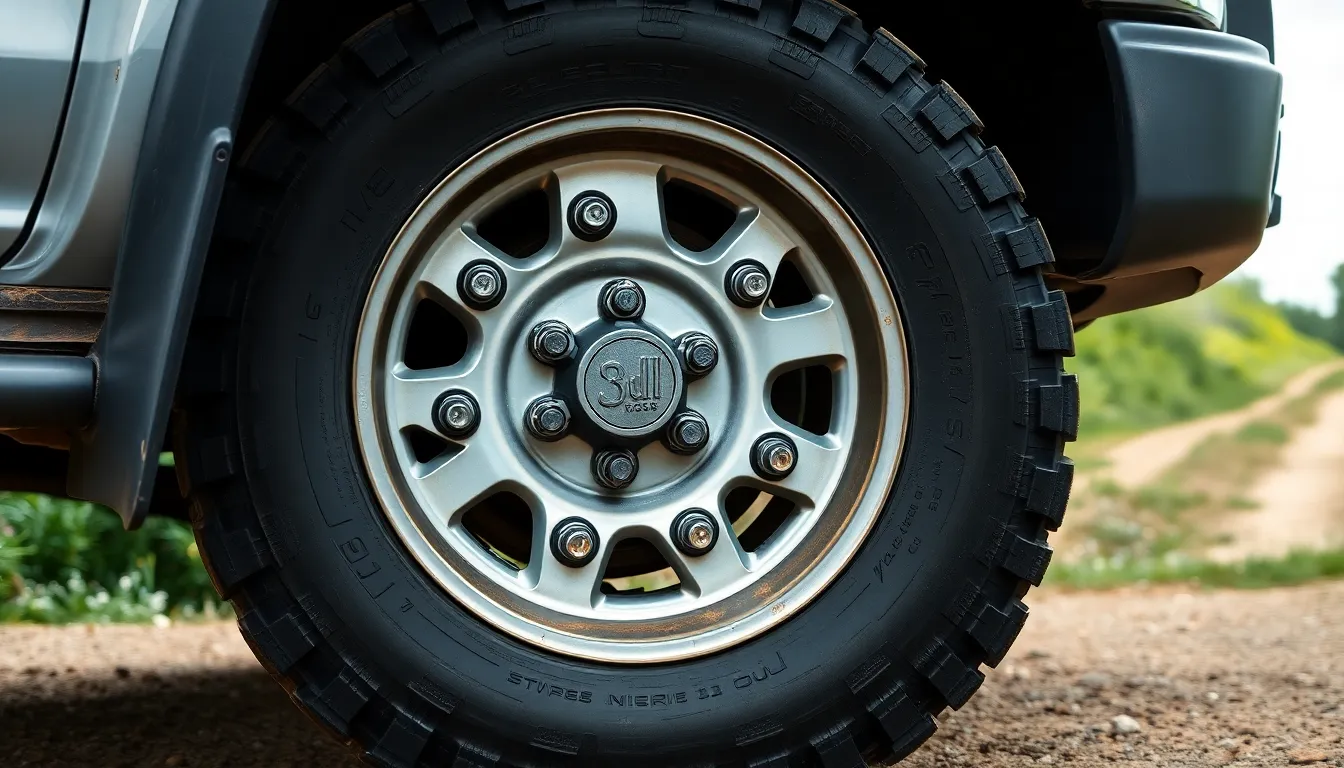Wondering about that 5 by 5 bolt pattern on your vehicle’s wheels? This critical measurement could make all the difference when you’re searching for replacement wheels or rims that actually fit your vehicle.
The 5×5 bolt pattern (also called 5x127mm in metric) is common on many popular trucks and SUVs, including certain Jeep, GM, and Ford models. When we talk about a 5×5 pattern, we’re referring to a wheel with 5 lug nuts arranged in a circle with a diameter of 5 inches. Understanding your vehicle’s bolt pattern is essential for proper wheel fitment and can save you time and money when upgrading or replacing your wheels.
What Is a 5 by 5 Bolt Pattern?
A 5 by 5 bolt pattern consists of five lug nuts positioned in a circle with a diameter of 5 inches (127mm) when measured from one lug to the opposite lug. This exact configuration serves as a critical measurement for wheel compatibility on many trucks and SUVs.
Measuring a 5 by 5 Bolt Pattern
Measuring a 5 by 5 bolt pattern accurately requires precise techniques to ensure proper wheel fitment. Center-to-center measurement involves calculating the distance between two opposing lug holes across the center of the hub. For five-lug patterns, measure from the back of one lug hole to the center of the opposite hole. Digital calipers provide the most accurate readings, though a tape measure works for basic measurements. Bolt pattern gauges offer another reliable option, allowing you to quickly determine the exact pattern without complex calculations.
Common Terminology and Variations
Bolt pattern terminology varies across regions and manufacturers, creating potential confusion when shopping for compatible wheels. Americans typically refer to this configuration as “5 on 5” or “5×5,” expressing measurements in inches. European and Asian manufacturers use metric measurements, labeling the same pattern as “5x127mm.” The 5×5 pattern has several close cousins including the 5×4.5″ (5×114.3mm) and 5×5.5″ (5×139.7mm) patterns. These subtle differences matter significantly—wheels with even slightly different bolt patterns won’t fit properly on your vehicle. Manufacturers occasionally use terms like “pitch circle diameter” (PCD) or “bolt circle diameter” (BCD) to describe the diameter of the imaginary circle formed by the lug holes, both referring to the same measurement critical for proper wheel fitment.
Vehicles That Use the 5 by 5 Bolt Pattern

The 5 by 5 bolt pattern appears on many vehicles across multiple manufacturers, making it one of the more common configurations in the automotive industry. This pattern, also expressed as 5×5 or 5x127mm, serves as the standard for many American-made vehicles and continues to be utilized in modern designs.
Popular Car Models
Several mainstream automotive brands incorporate the 5×5 bolt pattern in their vehicle lineups. Buick, Cadillac, and Chevrolet frequently use this configuration across their ranges. Chrysler vehicles often feature this bolt pattern, providing consistency for wheel compatibility. Daewoo, Dodge, and BAW have also adopted the 5×5 pattern for various models in their catalogs. Compact SUVs and crossovers like the Chevrolet Tracker (1989–2009) utilized the slightly larger 5×5.5 variation, offering robust performance while maintaining a relatively small footprint.
Trucks and SUVs
American trucks and SUVs represent the largest segment of vehicles employing the 5×5.5 bolt pattern, particularly highlighting its strength and durability attributes.
Ford’s iconic off-road models showcase this pattern extensively. The classic Bronco (1966–1996) utilized this configuration throughout its original production run. Ford’s workhorses, including the F-100 (1953–1983) and early F-150 models (1987–1996), relied on this bolt pattern to support their heavy-duty applications and load-carrying capabilities.
Dodge implemented the 5×5.5 pattern across several popular models. The Ram 1500 (1994–2010) featured this configuration, as did the mid-size Dakota (2005–2011) and the family-friendly Durango SUV (2004–2009). These applications demonstrate the pattern’s versatility across different vehicle sizes and purposes.
Jeep’s legendary CJ series (1945–1986) employed this bolt pattern, contributing to its renowned off-road performance and aftermarket modification potential. International manufacturers also adopted this configuration for their rugged vehicles. Suzuki utilized it for the compact but capable Jimny (1987–2023), Grand Vitara (1998–2005), and the iconic Samurai. Toyota’s Blizzard (1984–1990) and early Kia Sportage models (1994–2006) featured this pattern to support their utility-focused designs.
The 5×5.5 bolt pattern continues its relevance in contemporary vehicles, including cutting-edge electric models. Rivian’s electric adventure vehicles—the R1S SUV (2022–2024) and R1T pickup (2021–2024)—employ this traditional bolt configuration while incorporating modern electric powertrains, demonstrating how this classic pattern remains valuable even in next-generation vehicle designs.
Wheels Compatible With 5 by 5 Bolt Pattern

Compatible wheels for the 5 by 5 bolt pattern must match both the 5-lug count and have a precise 5-inch (127mm) bolt circle diameter. Accurate measurement from the top edge of one lug hole to the center of the opposite hole confirms this pattern and ensures proper fitment for your vehicle.
OEM Options
Original Equipment Manufacturer wheels designed for the 5×5 bolt pattern come standard on several popular vehicles. Jeep Grand Cherokee models feature this pattern prominently, offering reliable factory wheel options directly from the manufacturer. Older Chevrolet and GMC SUVs and trucks use this configuration, providing OEM alternatives that maintain factory specifications. Some Oldsmobile rear ends also incorporate this pattern, expanding the range of stock options available. These factory wheels deliver precise fitment with correct hub size and offset specifications, guaranteeing optimal safety and performance for your vehicle.
Aftermarket Choices
The aftermarket wheel industry offers extensive options for 5×5 bolt pattern vehicles due to its popularity among trucks and SUVs. Off-road enthusiasts appreciate heavy-duty wheels engineered specifically for this pattern, featuring reinforced construction that withstands extreme terrain and conditions. Manufacturers produce wheels maintaining the 5×5 lug layout while offering varied styles, materials, and finishes to match your aesthetic preferences and performance needs. Dual bolt pattern wheels provide additional versatility by accommodating multiple vehicle types while including the 5×5 configuration.
Many aftermarket 5×5 wheels excel at handling heavy loads and towing applications, making them ideal for working vehicles. These specialized wheels distribute stress evenly across the wheel structure, improving durability during demanding use scenarios. Custom finishes ranging from chrome to matte black allow you to personalize your vehicle’s appearance while maintaining the correct bolt pattern specifications.
Potential Issues With 5 by 5 Bolt Pattern

The 5 by 5 bolt pattern offers reliability for many trucks and SUVs, but certain complications can arise when working with this configuration. Understanding these potential issues helps prevent costly mistakes and safety hazards during wheel installation or replacement.
Fitment Challenges
Precise measurement is essential when working with the 5×5 bolt pattern. The bolt circle diameter must be exactly 5 inches (127mm) to ensure proper fitment. Measurement errors, such as measuring from center to center instead of edge to center, frequently lead to improper wheel mounting. Center bore size plays a crucial role in wheel stability and balance, requiring careful attention during selection.
Wheels must specifically match the 5×5 pattern to function correctly. Similar patterns like 5×5.5 or 5×139.7mm aren’t interchangeable even though their close resemblance. Attempting to mix different wheel specifications often results in noticeable vibration, driving instability, or complete inability to mount the wheel securely. Careless verification of measurements can transform a simple wheel upgrade into a frustrating and potentially dangerous situation.
Lug Nut Considerations
Lug nuts require compatibility with both the stud size and thread pitch exact to your vehicle’s 5×5 bolt pattern system. Incompatible lug nuts commonly cause loosening during operation, stripped threads, or inadequate wheel attachment. The lug nut seat type (conical, flat, or ball) must correspond precisely with your wheel’s lug hole design to distribute clamping force properly.
Safety experts consistently recommend using lug nuts designed specifically for your vehicle and wheel combination. This manufacturer-exact approach maintains optimal torque specifications and minimizes risks associated with improper fastening. Cutting corners on lug nut quality or compatibility compromises the structural integrity of the entire wheel assembly, potentially leading to catastrophic failures at highway speeds or during off-road adventures.
Converting to or From a 5 by 5 Bolt Pattern

Converting a vehicle’s bolt pattern to or from the 5×5 configuration requires careful consideration of compatibility factors to ensure safety and proper performance. This process involves either using wheel adapters for a temporary solution or completing a full hub conversion for a more permanent approach. Each method has distinct advantages depending on your vehicle modification goals and budget constraints.
Using Wheel Adapters
Wheel adapters provide a practical solution for fitting wheels with a 5×5 bolt pattern onto vehicles with different patterns, or vice versa. These metal spacers attach to your existing hub and create a new mounting surface with your desired bolt pattern. High-quality adapters typically cost between $100-300 per set and come in various thicknesses ranging from 1 to 2 inches.
Many off-road enthusiasts opt for adapters when converting from patterns like 5×4.5 to 5×5 to accommodate larger, more rugged wheels. The installation process takes approximately 1-2 hours per wheel and requires basic mechanical tools plus a torque wrench for proper tightening.
Adapters must be properly torqued to manufacturer specifications to prevent dangerous vibrations or potential wheel detachment. They also slightly increase your vehicle’s track width, which can affect handling characteristics and potentially require fender modifications for proper clearance. Regular inspection of adapter hardware is essential, as the additional connection point creates more opportunity for components to loosen over time.
Complete Hub Conversion
A complete hub conversion replaces your vehicle’s entire hub assembly with one designed for the 5×5 bolt pattern. This modification provides a factory-like fit without the additional thickness of adapters. Professional hub conversions typically cost $800-1,500 for parts and labor, making them a important investment compared to adapters.
Hub conversions often require complementary modifications to braking components, including rotors, calipers, and sometimes brake lines. The process takes 4-6 hours for a professional mechanic and demands specialized tools for proper installation. Many performance shops offer complete conversion kits for popular vehicles, simplifying the parts acquisition process.
The primary advantage of hub conversions is maintaining your vehicle’s original track width and suspension geometry while gaining compatibility with your desired wheels. This approach eliminates concerns about adapter reliability during high-stress driving conditions like towing or off-roading. Complete conversions also preserve factory-engineered load ratings and stress distribution across the wheel hub.
Custom fabrication may be necessary for rare vehicle applications without commercially available conversion kits. When planning a hub conversion, confirming compatibility with your exact vehicle’s year, make, and model is crucial for ensuring proper fitment and function of all components.
Conclusion
Mastering the 5 by 5 bolt pattern gives you a important advantage when upgrading or replacing wheels for your truck or SUV. This common configuration found on many American-made vehicles offers both OEM reliability and aftermarket customization options to suit your exact needs.
Whether you’re sticking with factory wheels or exploring heavy-duty alternatives for off-road adventures you now understand the critical importance of precise measurements. Remember that proper fitment isn’t just about aesthetics—it’s essential for safety and performance.
For those considering conversion options wheel adapters provide flexibility while hub conversions deliver a permanent solution. Whichever path you choose always prioritize compatibility and proper installation to ensure your vehicle performs at its best for years to come.
Frequently Asked Questions
What is a 5 by 5 bolt pattern?
A 5 by 5 bolt pattern (also known as 5x127mm) refers to a wheel with 5 lug nuts arranged in a circle with a 5-inch diameter. This pattern is commonly found on various trucks and SUVs from manufacturers like Jeep, GM, and Ford. Understanding this measurement is crucial for proper wheel fitment when replacing or upgrading your wheels.
How do I measure a 5 by 5 bolt pattern accurately?
To measure a 5 by 5 bolt pattern accurately, use center-to-center measurement between opposite lug holes. For best results, use digital calipers or a dedicated bolt pattern gauge. Measure from the center of one lug to the center of the opposite lug (for 5-lug wheels, measure to the farthest lug, not the adjacent one). The measurement should be exactly 5 inches (127mm).
Which vehicles use a 5 by 5 bolt pattern?
Many American-made trucks and SUVs use the 5 by 5 bolt pattern, including Jeep CJ series, Grand Cherokee models, Ford Bronco, various Chevrolet and GMC trucks/SUVs, Cadillac and Buick models, and Ram trucks. Some international manufacturers like Suzuki and Toyota also use this pattern. Modern electric vehicles from Rivian (R1S SUV and R1T pickup) also feature this bolt pattern.
What wheels are compatible with a 5 by 5 bolt pattern?
Compatible wheels must match both the 5-lug count and the precise 5-inch (127mm) bolt circle diameter. Options include OEM wheels from Jeep Grand Cherokee, older Chevrolet and GMC SUVs/trucks, and various aftermarket wheels designed for off-road use. Aftermarket options offer diverse styles, materials, and finishes, including heavy-duty reinforced wheels for extreme conditions and towing applications.
What issues might arise with a 5 by 5 bolt pattern?
Fitment problems can occur if measurements aren’t precise. The bolt circle diameter must be exactly 5 inches (127mm), and mixing similar patterns (like 5×4.5″ or 5×5.5″) can cause driving instability or improper mounting. Additionally, lug nuts must match the vehicle’s stud size and thread pitch to prevent loosening. Always use manufacturer-specific lug nuts to maintain safety and structural integrity.
How can I convert to or from a 5 by 5 bolt pattern?
You can convert using wheel adapters or a full hub conversion. Wheel adapters are a temporary solution allowing different bolt patterns to work together, while hub conversions provide a permanent, factory-like fit. Adapters are less expensive ($50-300) but add wheel offset. Hub conversions cost more ($500-1500) but offer better performance. Both methods require ensuring compatibility with your vehicle’s specifications.
What’s the difference between 5×5 and 5x127mm bolt patterns?
There is no difference. 5×5 (using inches) and 5x127mm (using millimeters) refer to the same bolt pattern. American manufacturers typically use the imperial measurement “5 on 5” or “5×5,” while European and Asian manufacturers prefer the metric equivalent “5x127mm.” When shopping for wheels, either designation indicates the same bolt pattern configuration.
Can I use wheels with a similar bolt pattern on my 5×5 vehicle?
No, you cannot use wheels with similar but different bolt patterns (like 5×4.5″ or 5×5.5″) on a 5×5 vehicle without adapters. Even slight differences will prevent proper mounting and create serious safety hazards. The bolt pattern must match exactly, as wheel studs must align perfectly with the holes in the wheel for safe operation.
